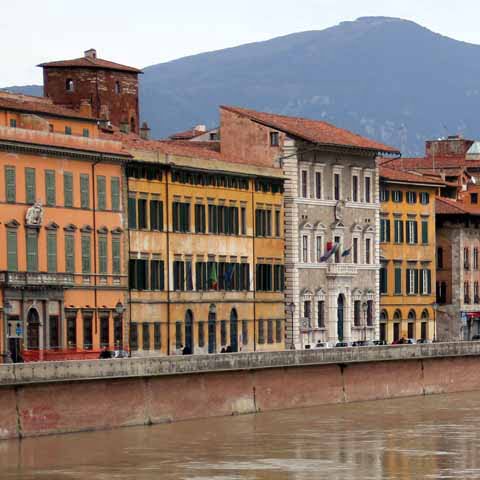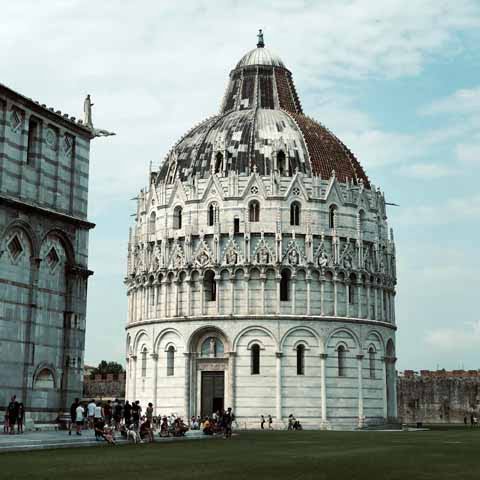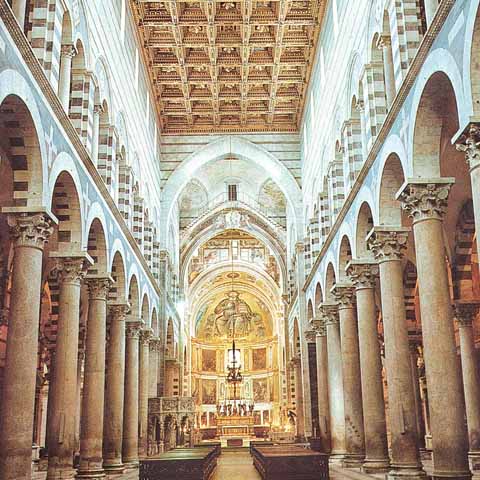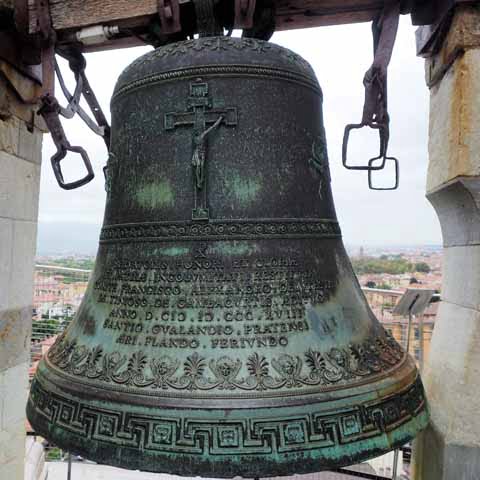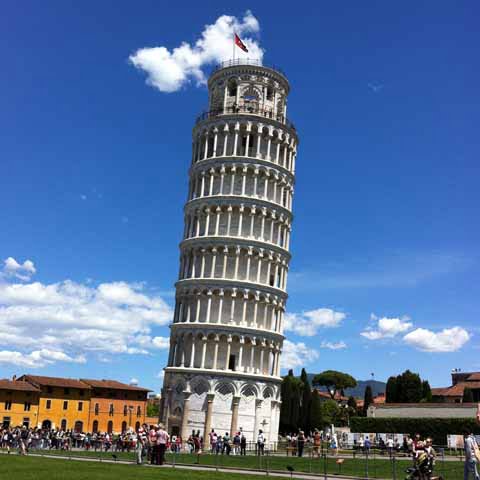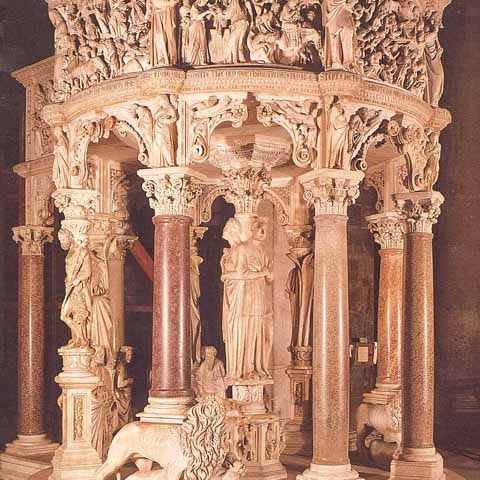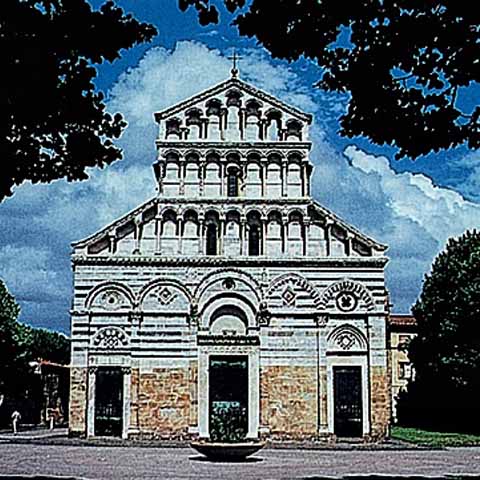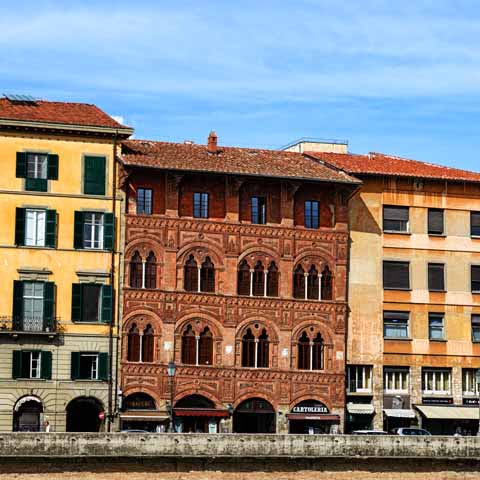While known primarily as a sightseeing travel destination, Pisa is culturally wealthy, offering visitors many enriching ways to take in the wonders of the city. With its vast history as a powerful Maritime Republic during the Middle Ages, Pisa has an air of ancient glory that somehow fuses effortlessly with the bustling, modern sensibilities of its student population. Travelers to the city enjoy the history and architecture they have come to expect, as well as lively, local activities that surprise and delight.
The most famous monument that has impacted Pisa’s local culture is the Leaning Tower. Conceived to serve as the bell tower for the Pisa Cathedral, the tower’s height varies from 183 feet to 185 feet depending on which side is measured. Construction began in 1173 and the tower’s distinctive lean appeared soon after as a result of soft soil that is incapable of properly supporting the tower’s weight. The initial lean was slight, though it increased in subsequent years, especially when the construction of the tower was completed almost two centuries after groundbreaking. Extensive stabilization works began in 1993 and by 2001 the tower’s lean was reduced from more than five degrees to just under four degrees.
Though best known for its tilt, the Leaning Tower of Pisa is an excellent example of Romanesque architecture. The tower features seven bells as well as rich decorations on its columns and walls. Today, visitors from all over the world make the journey to Pisa to climb the 296 steps and enjoy the view from the top of the tower.
In general, the culture of Pisa is rooted in education. Home to one of Italy’s most famous and highly-regarded universities – the University of Pisa – the city is dynamic due to its young population and centuries of tradition in academia. Established in 1343, the University of Pisa boasts a long history of providing elite education through the main college. Pisa is also home to two prestigious graduate schools – the Sant’Anna School of Advanced Studies and Scuola Normale Superiore di Pisa. In addition to having provided higher learning for some of the world’s greatest physicists, politicians, scientists, presidents, and poets, the education scene in Pisa helps to shape the city culturally. From cafés and restaurants to bars and nightlife, the large student population brings a sense of fun, excitement, and opportunity to Pisa.
Along with the University, the Arno River is one of the key features of Pisa that shapes the local culture. Much of local life is lived upon the lungarni – the embankments on either side of the river. Common activities for locals along the lungarni include relaxing while drinking coffee, and simply watching the world go by. Students often read or study there while everyone, including travelers, takes a casual stroll. The Ponte di Mezzo bridge is the most popular location to congregate around, but the entire river, which splits the city, is a key aspect of Pisa locals’ daily life.
Pisa’s history with water extends as far back as its beginning as a maritime power. The influence of this time is reflected in the modern-day culture by its longstanding rivalry with the nearby city Livorno, known in English as Leghorn. This tradition of witty banter and good-humored jokes between the two cities has existed since the Medici Family created the city of Livorno and in turn, a lighthearted rivalry began that would last for centuries and solidify into the Tuscan folklore and culture. Pisa is also known for its rivalries with other Tuscan cities including neighboring Lucca as well as Florence.
ART
The city of Pisa is an open-air museum with something beautiful to take in at every turn. From its stunning bridges and palazzi to breathtaking frescoes and museums – including the Museo dell’Opera del Duomo, the Museum of Graphic Arts, and Palazzo Reale – it is no wonder that the city serves as an inspiration to many budding artists.
One of the most important artists to hail from Pisa is Nino Pisano. Born in 1315, Pisano would become an incredible sculptor whose works would be displayed in many churches, including his most celebrated work, Madonna col Bambino, which is on display at the Church of Santa Maria Novella in Florence. In Pisa, Pisano’s sculptures can be admired in the Church of San Nicola, the Church of San Michele in Borgo, the Church of Santa Maria della Spina, and the Pisa Cathedral Museum.
For a unique artistic experience in Pisa, visit the center of the city to see Keith Haring’s final public work, Tuttomondo. One of the most influential artists of the 80s and 90s, Haring’s unique pop art style is one of the most recognizable in the world. Located on one of the walls of the Convent of Servi di Maria, the mural is a remarkable endpoint to Haring’s career and attracts visitors from all over the world.
Before the Leaning Tower became famous worldwide, the Campo Santo Monumental Cemetery was Pisa’s original claim to fame. Dating back to the thirteenth century, the cemetery is said to have been built around holy soil from Golgotha that was brought to Pisa during the Crusades. The original purpose of the cemetery was to hold Roman sarcophagi from Pisa’s Cathedral. The cemetery is best known for its historic frescoes from the fourteenth to the seventeenth centuries. Several important Italian artists are represented here including Francesco Traini, Buffalmacco, Benozzo Gozzoli, and Andrea Bonaiuti. The frescoes were severely damaged during incendiary bombing in World War II. Following the war, extensive restoration works commenced in order to salvage the frescoes.
One of the most remarkable sculptures in the city of Pisa is the Madonna and Child known as Madonna dei Vetturini. Believed to be the work of Nino Pisano, the sculpture was originally on display in the Church of Santa Maria della Spina. It was moved in the sixteenth century and today the original is on display in the San Matteo Museum, while a copy can be admired in the arcades of Borgo Stretto.
As for museums, there are plenty of options worth visiting while in Pisa. One example is the Museo dell’Opera del Duomo, which houses the treasures of Pisa’s Cathedral as well as sculptures by Giovanni and Nicola Pisano. Located in Piazza dei Miracoli, this museum is considered to be one of the most visited museums in the country.
Museo Nazionale di San Matteo is one of the best places in Pisa to admire Medieval and Renaissance art. The impressive museum boasts art from the twelfth to the fifteenth centuries with works by Giovanni Pisano, Andrea Pisano, Nino Pisano, Simone Martini, and more.
For a fascinating look at Pisa’s past, visit the Museo of Palazzo Reale (the Royal Palace). Located along the Arno River, this stately building was commissioned by the Medici during the sixteenth century. Over the years, the palace was used by Pisa’s numerous ruling families. Here, visitors can admire historic tapestries, armor, paintings, sculptures, and more. Among the works displayed, there is even an early painting by Raphael entitled Miracolo degli impiccati.
Also positioned along the Arno River is the aptly named Palazzo Blu. This striking blue building is a venue for unique temporary exhibitions and a hub for cultural activities. It is also home to a permanent collection with works from the Middle Ages through the nineteenth century featuring paintings by Francesco da Volterra and Getto di Jacopo, as well as coins and ancient artifacts.
ARCHITECTURE
Pisa is known worldwide for the incomparable Leaning Tower, however, visitors must experience more than just the tower to appreciate the full scope of the city.
The complex in which the tower sits offers guests the stunning Cathedral of Santa Maria Assunta (also known as the Duomo of Pisa). Often overlooked due to its proximity to the Leaning Tower, this building is one of Italy’s most spectacular churches and one of the leading examples of the city’s unique Pisan Romanesque style. Dating back to the eleventh century, the many treasures of the cathedral include the bronze doors, the intricate pulpit created by Giovanni Pisano, and Cimabue’s last painting located in the apse, which depicts Saint John.
Nearby, one will find the Baptistery – Italy’s largest baptistery and an amazing example of Romanesque and Gothic architecture. Dedicated to Saint John the Baptist, the baptistery dates back to the twelfth century. The main structure was designed by Diotisalvi in the Romanesque style. However, the baptistery remained unfinished until the fourteenth century when father and son sculptors Nicola and Giovanni Pisano added the final level with the dome and loggia. These new architectural elements were created in the Gothic style. The interior is noteworthy for the baptismal font designed by Guido Bigarelli da Como and the pulpit created by Nicola Pisano.
Also located in Piazza dei Miracoli is the Ospedale Nuovo di Santo Spirito. This thirteenth century hospital was created to provide shelter to abandoned children, the poor, the sick, and pilgrims. The exterior of the complex features Gothic architecture and was restructured during the Renaissance. Today the complex is home to the Sinopie Museum where preparatory drawings and frescoes can be admired.
Outside of Piazza del Duomo, the city of Pisa is home to several other important churches. A few examples include the Church of Santa Maria della Spina (a riverside church renowned for its Gothic architecture), the Church of San Francesco (a Gothic and Renaissance church that is the second largest church in Pisa), and the Church of San Frediano (a Romanesque church with Baroque elements).
In Pisa’s Piazza dei Cavalieri, travelers can gaze upon the incredible architecture of the Scuola Normale Superiore. This school is one of the top 50 in all of Europe and features elegant statues carved into the face of the building.
Pisa is also home to several elegant palaces. Among these is Palazzo Spinola, which was in the possession of several local noble families, such as the Appiano family, before becoming the Medici residence in the city in 1446. During this period, the palace underwent Renaissance renovations and eventually Neo-Gothic elements were added under the instruction of Marchesa Vittoria Spinola, daughter of King Vittorio Emanuele II. Today, the building hosts the Prefecture of Pisa.
Another splendid palace is known as Palazzo Gambacorti. Located along the Arno River, this structure dates back to the fourteenth century and enchants visitors with its Gothic features including the mullioned windows. The interior is Neo-Classical and features elegant frescoes and stucco decorations. Today, the building hosts Pisa’s Town Hall.
Among Pisa’s stunning Medieval buildings, perhaps one of the most famous is the Torre del Campano, which was once known as Torre dei Caciaioli. The five-story bell tower is among the better-preserved towers in the city. Today, the bell is used to signal class periods at the nearby university.
LITERATURE
Though Pisa is an area of Italy bursting with intellectuals and academics, Pisa has also produced some incredible artists of various mediums.
The thirteenth century writer Rustichello da Pisa was born in Pisa. He wrote in the Franco-Italian language and is the author of Marco Polo’s renowned autobiography The Travels of Marco Polo. The two collaborated while they were imprisoned in Genoa, with Marco Polo telling stories of his travels and Rustichello putting them to paper.
Italian writer, translator, and scholar Antonio Tabucchi was born in Pisa. He is most widely known for his deep appreciation of the Portuguese language. He would go on to write many books that would be translated into 18 different languages and eventually teach at the University of Siena. He embodied the intellectual spirit of Pisa, not just in his writing but also in his passion for the world of academics.
Additionally, Gabriele D’Annunzio, one of Italy’s greatest poets and writers, is the source of Piazza del Duomo’s famous nickname, Piazza dei Miracoli. The author referred to the square as “prato dei miracoli” (meadow of miracles) in his 1910 novel Forse che sì forse che no and the name has been used ever since.
CINEMA
With its striking Leaning Tower and historic atmosphere, Pisa has long attracted filmmakers. In fact, Tirrenia, a hamlet of Pisa, was home to Pisorno, a film studio open from the 1930s to the 1960s. In its heyday, Pisorno was regarded as one of Italy’s top film studios. Among the movies filmed at Pisorno are I due sergenti (1936), Il re d’Inghilterra non paga (1941), and Madame Sans-Gêne (1961).
Two of Italy’s most celebrated film directors, Paolo and Vittorio Taviani (known as the Taviani Brothers) were born in the province of Pisa approximately 30 miles southeast of the city in the town of San Miniato. The pair collaborated on numerous films throughout their careers both as directors and as screenwriters, with several films winning at the Cannes Film Festival and the Berlin International Film Festival. Their acclaimed films include Padre Padrone (1977, filmed in Pisa), La notte di San Lorenzo (1982), Cesare deve morire (2012), Maraviglioso Boccaccio (2015), and Una questione privata (2017).
Pisa born screenwriter and director, Paolo Benvenuti is known for his unique flair and sophisticated artistic approach to filmmaking. His films, such as The Kiss of Judas (1988) and Gostanza da Libbiano (2000) captured the Italian spirit of classic theater.
Gillo Pontecorvo was another film director born in Pisa. His films include The Wide Blue Road (1957), Kapò (1959), The Battle of Algiers (1966), Burn! (1969), and Operación Ogro (1979).
Naturally, the Leaning Tower of Pisa is an iconic symbol in all artistic mediums, including film. As a result, several movies have been set or filmed in Pisa, either fully or partially, including Totò al giro d’Italia (1948), Souvenir d’Italie (1956), Noi siamo le colonne (1956), La ragazza del Palio (1957), Esterina (1959), Medea (1969), Padre Padrone (1977), Amici miei atto II (1982), Figlio mio infinamente caro (1985), Superman III (1986), Il burbero (1986), Good Morning Babilonia (1987), and Ora o mai più (2003).
SCIENZE
With the University of Pisa cultivating such a massive value of education in the area, many incredible scientists have hailed from Pisa, impacting not just the local culture but also that of the entire world.
The father of modern physics, Galileo Galilei, was born in Pisa and attended the University of Pisa. He ultimately went on to make some of physics and astronomy’s greatest discoveries and was an outspoken champion of heliocentrism. One of the key sites in Pisa tied to Galileo is Casa Ammannati, which was the birthplace of Galileo and his maternal family home. Nearby, is the Church of Sant’Andrea Foris Porta, which is where Galileo was baptized.
Leonardo Bonacci, better known as Fibonacci, the Middle Ages’ most important mathematician, also hailed from Pisa. He introduced the sequence known as the Fibonacci numbers to Europe and helped popularize the Arabic numerical system in Western mathematics.
Antonio Pacinotti – born in Pisa and eventual professor at the University of Pisa – was a notable physicist who invented the dynamo.
MUSIC
Pisa has a long history of religious music that can be traced back to the Middle Ages. Evidence of the city’s role in music can be seen in Pisa’s archives.
One notable local musician was Francesco Palmieri, who was also a poet. Born in Pisa during the seventeenth century, Palmieri wrote collections of canzoni and oratorios, though most of these works were never published. He also wrote several librettos and was an accomplished singer.
During the nineteenth and twentieth centuries the Pisa Cathedral often hosted operas (in some cases first editions) by the likes of Vincenzo Bellini, Gaetano Donizetti, Giuseppe Verdi, Alfredo Catalani, Giacomo Puccini, and more. More recently, the famous opera singer Andrea Bocelli grew up just south of Pisa and studied at the University of Pisa.
Though Pisa’s world-famous Leaning Tower is certainly a remarkable example of Italian architecture, the city’s cultural life runs deeper. With stunning churches, elegant palaces, and rich museums filled with historic art, there is plenty in Pisa to keep visitors entertained, beyond the Leaning Tower.
Don't just see Italy, live it.
Your dream trip to Italy has never been closer
No more endlessly scrolling travel sites. Our travel experts will craft the perfect, one-of-a-kind trip just for you.

300+
DESTINATIONS
We offer more Italian destinations than any travel site. Do and see more with Trips 2 Italy.
1 (of a kind)
ITINERARIES
Because your dream trip to Italy should be designed for you, not for the masses.
100%
PEACE OF MIND
From flights and accommodations, to food and activities - we take care of every detail.
